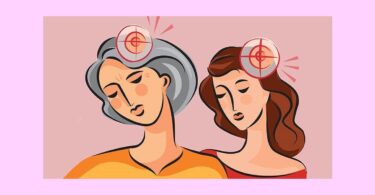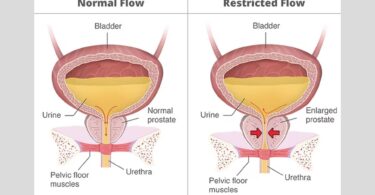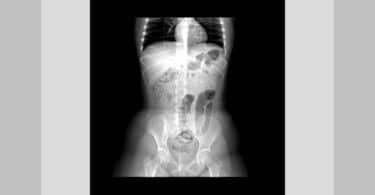This is the case of a male, 50 years of age, who presented at the Palghar Hospital OPD on 20th August ’05 with tingling/numbness of the upper and lower limbs on the left side. This had begun 10 days earlier and was progressively getting worse. It began with weakness of the limbs on the left side and he was now unable to move them. An episode of severe anxiety and fear had precipitated this onset of symptoms. It had progressed further and now he had slurred speech and was laughing immoderately. He also had a strong feeling of being intoxicated ++. Along with this there had been a recurrent headache that tended to be worse in the morning, around 9-10 am.
2 months earlier he had developed hypertension. The symptoms at that point were a similar tingling and numbness on the left upper and lower limbs. This too, was precipitated by an episode of fear. He was put on anti hypertensive medication which helped and he stopped this on his own after a while.
There were no other CNS symptoms of unconsciousness, projectile vomiting, convulsions, fever or head injury.
There was no Past History of diabetes, or ischemic heart disease as possible precipitating factors.
On Examination:
Pulse: 84/min
BP: 150/100
RS: Clear
CVS: S1S2 Normal
PA: NAD
CNS: Conscious, Cooperative, Well oriented in time, space and person
Higher Functions, Cranial Nerves: Normal
No Palliloedema
| Motor | Right | Left | |
| Tone: UL | Normal | Increased ++ | |
| Tone : LL | Normal | Increased ++ | |
| Muscle Power: UL | Normal | Proximal Muscles: Power 1/5 Distal Muscles: Power 4/5 | |
| Muscle Power: LL | Normal | Complete loss of power: 0/5 | |
| Reflexes: UL | Normal | Hypertonic ++ | |
| Reflexes: LL | Normal | Hypertonic ++ | |
| Sensory | Normal | Loss of fine touch in Upper and Lower limbs |
At this point in the OPD we had to decide whether this case needed to be admitted as inpatient for homeopathic management. We follow a set of criteria to make this decision for all cases, including this one. Here are the criteria that indicate mandatory in-patient admission for a homeopathic patient.
- Close monitoring for a potentially fatal illness
- Observation for developing complications.
- Detailed investigation of the acute condition and risk factors.
- Homoeopathic remedy reaction
- Ancillary measure – physiotherapy
In this case, hospital admission was a necessity for further investigations and management to be carried out.
Investigations:
- Hb : 15.2
- T.L.C.: 7800 N 68 E 0 B 0 L 26 M2
- RBS : 65.2
- B .U. N. :9.0
- S. CHOLESTROL : 300.2
- S . TRIGLYCERIDES : 254
- S. CREAT : 1.0
E.C.G. : L.V.H. Pattern
CT SCAN – BRAIN (Pictures can be viewed in the attached slide presentation)
E/o ill-defined hypodense lesion seen in the Rt high parietal lobe involving centrum semi ovale, mostly suggestive of recent non-hemorrhagic infarct in Rt MCA area.
E/o multiple lacunar infarcts in Rt internal capsule & basal ganglia.
E/o old small size infarct in Lt anterior limb of internal capsule in Lt MCA area. Periventricular white matter ischemic changes seen.
FINAL DIAGNOSIS:
LT SIDED HEMIPLEGIA, secondary to Right MCA (Middle Cerebral Artery) non-hemorrhagic infarct involving the parietal lobe of the cerebrum.
HYPERTENSION
HYPERLIPIDAEMIA
Management:
Once these preliminary medical observations are complete, we must now appraoch the case from the homeopathic standpoint for appropriate homeopathic management and care. In fact the homeopathic diagnosis is an integrated ongoing process even through the medical work being done above.
What is obvious from above, is that there already exists a chronic process going on over many months that has precipitated now as a hemiplagia (stroke). This is an acute complication of chronic disease. Our plan was to decide on the acutely indicated remedy to overcome this acute picture of symptoms, followed by the constitutional remedy. This is how we reasoned it out:
Acute remedy: There was a distinct change in the susceptibility during the acute episode that presents with new symptomatology, a clear causative factor and characteristic modalities and concomitants. These were indications for an acute remedy.
Constitutional remedy: Is expected to continue with healing of the infracted area of the brain. It is also expected to deal with the underlying causes of hypertension and hyperlipidaemia so that such episodes will not recur. In addition, the constitutional remedy must deal with the excessive tendency to be morbidly anxious and fearful over circumstances.
With this philosophical understanding of our approach, we concentrated on the acutely presenting totality which was as below:
Ailments From FRIGHT / FEAR
< ANXIETY
HEAD PAIN MORNING 10 a. m. <
STUPEFACTION, AS IF INTOXICATED, HEADACHE DURING,
LAUGHING TENDENCY, IMMODERATELY
PARALYSIS, NUMBNESS WITH,
PARALYSIS, PAINLESS
PARALYSIS ONE SIDED – LEFT
These were the rubrics chosen. Our next step was to consider which repertorization approach was appropriate to this case given the characteristic picture. Since there was characteristic sensation, modalities, concomitants, and causation, we chose the Boenninghausan’s approach for repertorization.
The remedies that came up were: Nux Moschata, Gelsemium, Opium, Rhus tox, Causticum.
Furthur discussion was required to decide on the appropriate remedy.
Along with this we also made an assessment of the Susceptiblity:
- Susceptibility: Low Sensitivity: High
- Pace: Slow
- Characteristic: Few
- Pathology: Structural – Irreversible
- Vital organ affected
Hence the choice of posology was: Low potency with frequent repetition.
The next step was to evaluate the underlying Miasm:
- 10 a.m. <
- SLOW PROGRESS
- CONFUSION
- INTOXICATED FEELING
- IMMODERATE LAUGHTER
- STIFFNESS
- HYPERLIPDAEMIA
The miasm is SYCOTIC
The final choice of remedy was Gelsemium 30C.
Follow Up:
21/08/05:
- No headache, no giddiness,
- Mild nuchal pain.
- TINGLING NUMBNESS > 50%O/E:
- BP- 140/90
- Lt: UPPER LIMB & LOWER LIMB
Hypertonia++
Power – left shoulder 4/5 > ++
left hip 3/5
knee & ankle 0/5
Plan: Continue Gelsemium 30 QDS
23/08/05:
No TINGLING NUMBNESS.
Sensation of tightness in left upper and lower limbs > 75%
POWER: SAME
Plan: Gelsemium 200 QDS
26/08/05:
NO SUBJECTIVE COMPLAINTS
APPETITE, SLEEP NORMAL
POWER: SAME
The patient is now able to walk with support. But this support too is less that what he required earlier.
Plan: To be Discharged and follow up in OPD regularly.
Continue: Gelsemium 1M QDS.
At this stage we also considered the Chronic totality for a similimum so as to be able to appropriately begin with chronic treatment when clinically indicated. Here is the chronic picture:
The patient as a person:
- He has 5 duaghters whom he loves very much.
- Of all these, his 3rd daughter’s situation worried him the most. This daughter’s husband was alcoholic and had allegedly killed his first wife in a drunken rage.
- Hence the patient remained constantly in touch with this daughter on the phone. He remained tremendously anxious about her.
- 2 months ago when the hypertensive episode precipitated he had been unable to talk to her on the phone. Not knowing the reason for this, his got very afraid and thought that her husband had killed her. His BP went up with the intense anxiety and he began to have tingling numbness on his left side.
- Presently due to his deteriorating health, he remains very anxious about his daughter’s future due to her alcoholic husband and his own wife’s future, as he did not have any sons.
- He was a conscientious and a hard worker in order to support his large family of daughters.
- In addition he is chilly, has aversion for sweets.
The Totality based on this information is:
- ANXIOUS
- INDUSTRIOUS
- SYMPATHETIC
- SENTIMENTAL
- AVERSION SWEETS
- CHILLY
The constitutional remedy chosen was Causticum.
Follow up:
29.8.05
On Gelsemium 1M, his gait improved further, there was no more tingling numbness, his BP was 120/80. But the weakness in his muscle power remained the same.
He was now put on Causticum 30C, 1 single powder at bedtime.
14.9.06
No intoxicated feeling
No headache
No Tingling Numbness
Power Improved:
- Left Hip: 3/5
- Left knee: 1/5
- Left Shoulder: 4/5
Plan: Causticum 30C, 1 dose power daily at bedtime for 7 days.
His power continued to improve and he was normal with blood pressure well within control, anxiety considerably lessened. His lipid levels also began to reduce in time. The healing and resolution took place over a period of just a few weeks – which is remarkable in itself. That the patient chose to begin homeopathic treatment right at the outset was an important reason for such a quick resolution, before any other medication interfered with response of the vital force to an appropriate simillimum.
This is a clear example of how serious cases can be managed effectively on homeopathic treatment and management without any need for allopathic interventions, provided we have our principles of remedy choice and management clearly in place.
Click here to download the powerpoint presentation of this case.
Thank you,
Dr. Niranjan Pai, Medicine Part II
with Dr. Navin Pavaskar
Medicine Department
Dr. M.L. Dhawle Memorial Trust’s Rural Homeopathic Hospital,
Opp S.T. Workshop, Palghar – Boisar Road,
Palghar 401 404, Maharashtra, India
PH: (02525) 256932, 256933





Good case and its treatment. presently I have a case of CVA due to high content of alcoholism, age 50 years, male, started him on causticum 30ch, good response, but patient stopped treatment and restarted 3 months later. What do you suggest?